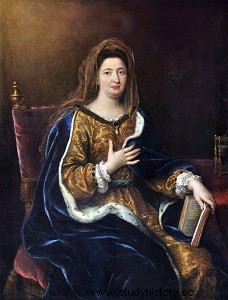
MAINTENON (Françoise d'Aubigné, Marquise de)
(Niort, 1635 - Saint-Cyr, 1719.) Granddaughter of Agrippa d'Aubigné, she was educated in Calvinism by an aunt , then spent several years in the West Indies with her father.
Returning to France on the latter's death, Françoise d'Aubigné was brought up by a 'Catholic godmother who entrusted her to the Ursulines and, at 15 years old, she converted to Catholicism. After this eventful childhood, she was married in 1652 to the comic poet Scarron, a great paralytic whose house and "salon" she held worthily, which was frequented by the most beautiful minds. Everyone, from Mesdames de Sévigné and de La Fayette to Messrs. d'Albret and de Villarceaux, praised her beauty, her spirit, her reserve. On the death of her husband in 1660, she kept her brilliant relations and continued "widow, young, gallant" to frequent the hotels of Richelieu and Albret. Ninon de Lenclos* is her friend. Her reputation was such that she was chosen in 1669 to raise with dignity the royal bastards of Madame de Montespan, cousin of Marshal d'Albret. She also had a vocation as a pedagogue and Abbé Gobelin, her spiritual director, encouraged her in this direction. Louis XIV, who often visits his children, quickly takes an interest in this pretty, intelligent, reserved and somewhat mysterious widow. He finds more and more pleasure in his solid and unfrivolous conversation. Under the pretext of thanking her for raising her bastards, he offers her the marquisate of Maintenon. Then he legitimized his bastards, thus opening up the Court to Madame de Maintenon who, in 1670, became the new runner-up’s second lady. The Court, seeing its intimacy with the king grow, wondered. "Some," Saint-Simon tells us, "regarded Madame de Maintenon as the king's confidante, others as a go-between, others as a skilful person whom the king used to write the Memoirs of his reign. It is certain that the clothes, the fit and the manners, we did not know who we were dealing with. In any case, Louis XIV was firmly in love and, when Queen Marie-Thérèse died in July 1683, it was the secret marriage, perhaps as early as September, or in January 1684, in any case blessed by the Archbishop of Paris, Harlay de Champvallon. At the age of 45, Louis XIV has definitively renounced his deviations and is preparing, alongside his new wife, for a dignified, pious and family old age, surrounded by his children and grandchildren. The Court, from libertine, becomes devout. "The king imagines that one is pious if one is bored", wrote Princess Palatine.
Over the years, Madame de Maintenon became a rather austere lady, little smiling, and who seems dry-hearted. But, if she is sober and thrifty for herself, she has all the weaknesses for her brother, the extravagant Comte d'Aubigné. She sometimes finds it hard to bear court life which, in her eyes, sums up as follows:“We play, we yawn, we get bored, we envy each other and we tear each other apart. The parties are chores for her. A pacifist like Fénelon, she shows in her Letters the painful part she takes in the miseries and setbacks of France. But his political role may not have been as considerable as one might think. If she works for the conversion of Protestants, she does not seem to have pushed for the revocation of the Edict of Nantes. It is no less true that, encouraged by her new director, Godet des Marais, Bishop of Chartres, she is an adviser, perhaps discreet and retiring, but often listened to. The king holds council in the room where she does tapestry and often asks her for her opinion. The ministers must avoid displeasing her:she pushes or serves some of them, hates Louvois who owes her his semi-disgrace, and on the contrary supports the Colbert clan for his piety. She undoubtedly had less influence than the confessors of Louis XIV, the fathers of La Chaise and Le Tellier, being moreover more concerned with her salvation and that of the king than with earthly politics. May I serve the safety of the king! Let me run away with him! she wrote.
In 1686, she had founded an institution for poor young girls of the nobility, the house of Saint-Cyr, which she directed closely and to which she interested the king. It was the dear work of her life and it was there that she decided to retire in 1715, after the death of Louis XIV.
